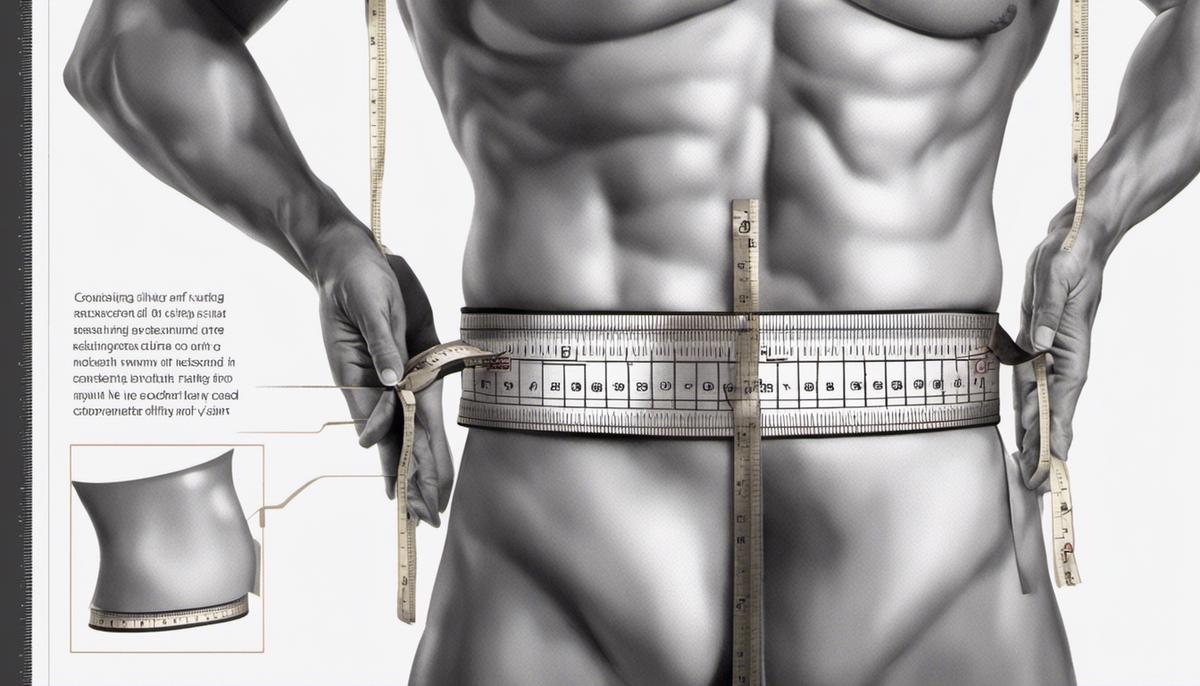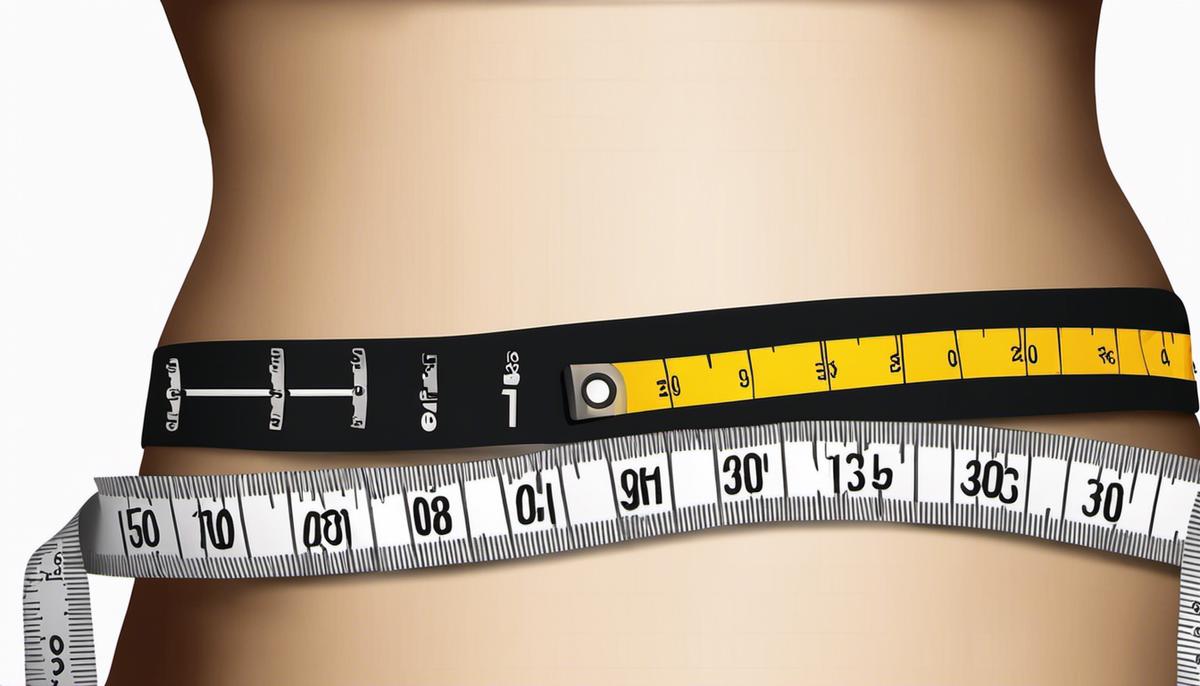Abdominal girth measurement is a valuable tool in assessing overall health and fitness, quantifying our daily lifestyle choices. It is a simple, yet often neglected aspect of health monitoring, even though it provides significant insights into our wellbeing. In this write-up, the fundamental knowledge about abdominal girth measurement, its importance in indicating potential health risks, its role in tracking weight loss and fitness, and common errors in its measurement are thoroughly discussed. This compilation aims to elucidate the significance and relevance of measuring abdominal girth in a way that is easy to understand for the general public.
Fundamentals of Abdominal Girth Measurement
Understanding Abdominal Girth Measurement
Abdominal girth measurement, also commonly known as waist circumference, is a simple and noninvasive biomarker of abdominal fat distribution. Abdominal fat plays an important role in predicting the risk of developing metabolic and cardiovascular diseases, beyond the measurement of body mass index (BMI). Abdominal girth measurement is generally used to assess the risk of obesity-related diseases.
The Purpose and Use of Abdominal Girth Measurements
Health professionals use abdominal girth measurements to evaluate an individual’s health risks related to being overweight or obese. Increased abdominal fat is associated with a higher risk for the development of chronic diseases such as hypertension, type 2 diabetes, heart disease, stroke, and certain types of cancer. Therefore, understanding one’s abdominal girth could serve as a useful predictor and preventative measure against these potential health problems.
Who Needs Abdominal Girth Measurement?
Typically, adults are the main demographics who need regular abdominal girth measurements. However, any individual, regardless of age, who is above a healthy weight for their height may benefit from this measurement. It’s especially relevant for individuals who carry excess weight in their abdomen, rather than in other parts of their body.
Procedure of Measuring Abdominal Girth
The procedure of measuring abdominal girth is straightforward and often performed by a healthcare professional. The individual should stand up straight during the procedure. A flexible, non-stretchable measuring tape is wrapped around the waist at the midpoint between the lower margin of the last palpable rib and the top of the hip bone, ensuring that the tape is horizontal around the waist. The individual should breathe out normally, and the measurement is then read to the nearest 0.1 cm.
Understanding the Tools for Measuring Abdominal Girth
Efficient and accurate measurement of abdominal girth, often identified as waist circumference, relies upon a select few key tools. At its most basic, a non-stretchable and flexible measuring tape that can ensure precise readings forms a significant part of this process. These tapes usually offer measurements in both centimeters and inches for the sake of convenience and global usage. To further improve ease and accuracy, certain healthcare practitioners may prefer using specialized devices, such as a ‘body circumference tape measure’ or a ‘waist circumference measuring tape.’ These devices are deliberately designed for such specific measurements and hence guarantee reliable and straightforward results.

Significance of Abdominal Girth Measurement
Why Measuring Abdominal Girth Matters
The measurement of abdominal girth, or waist circumference, holds notable importance in assessing an individual’s overall health risk. Alongside other health metrics like weight and Body Mass Index (BMI), abdominal girth forms an integral part of creating a comprehensive health profile. It is particularly instrumental in evaluating risks associated with obesity and overweight issues, especially those related to central obesity. Despite the widespread use of Body Mass Index (BMI) as a diagnostic tool for obesity and overweight status, it falls short in differentiating between lean mass and fat mass. This is where the significance of abdominal girth shines through, offering more precise insight into potential health concerns.
Health Risks Associated With High Waist Circumference
Several potential health risks are connected to a high abdominal girth measurement. This is particularly concerning in terms of visceral fat which isn’t brazenly visible not like subcutaneous fat, which settles underneath the skin. Visceral fat hides in the spaces between abdominal organs and secretes substances that can lead to inflammation, insulin resistance, and other metabolic disruptions. Studies show that an increased waist circumference can be linked to a higher risk of heart disease, type 2 diabetes, hypertension, abnormal cholesterol or triglyceride levels, and other metabolic disorders.
Abdominal Girth Norms: Age Groups and Genders
The norms for abdominal girth measurements depend on several factors, including gender and age. For adult men, a waist circumference greater than 40 inches generally indicates an unhealthy concentration of abdominal fat, which can pose several health risks. Meanwhile, for adult women, a measurement exceeding 35 inches is typically a cause for concern. It’s important to remember that these are general guidelines and individual health risks can fluctuate based on personal and familial medical history.
Abdominal Girth: A Vital Indicator of Overall Health
Observing and understanding your abdominal girth measurement can offer crucial insights into your overall health status. This measurement isn’t just about identifying disease risk, but it also provides valuable information about your organ function. Too much abdominal fat can put undue pressure on the organs lying within your abdomen, potentially disrupting their operation. Additionally, it can lead to hormonal imbalances and inflammation, contributing to conditions such as obesity, diabetes, and heart disease.
Paying attention to your abdominal girth is therefore a proactive way to manage your health, permitting necessary interventions if needed. Through regular exercise and a balanced diet, one can strive to maintain a healthy waist size, improving overall health and lifespan. A healthcare professional should always be consulted for personalized advice on maintaining optimal bodily measurements and achieving comprehensive health management.

Role in Tracking Weight Loss and Fitness
The Importance of Abdominal Girth in Weight Management and Physical Fitness Assessment
Monitoring the measurement of your abdominal girth, commonly referred to as waist circumference, is of significant importance in weight management and the assessment of physical fitness. It acts as a reliable indicator of visceral fat, which is directly linked to various health complications, such as heart disease, diabetes, and certain types of cancer.
What is the Body Mass Index (BMI)?
For one to understand its connection with abdominal girth, being acquainted with the concept of Body Mass Index (BMI) is important. The BMI is a simple calculation using a person’s height and weight. Although it does not directly measure body fat, it somewhat correlates to direct measures of body fat such as underwater weighing and dual energy x-ray absorptiometry (DXA). BMI is an inexpensive and easy-to-perform method often used to determine if a person has a healthy body weight.
How Does Abdominal Girth Measurement Relate to BMI?
Abdominal girth and BMI are both metrics used to assess the health risks associated with body size. However, the abdominal girth measurement can offer additional insights that BMI cannot because it focuses specifically on abdominal fat. Some individuals may have a ‘normal’ BMI but still carry high amounts of abdominal fat, increasing their risk of health issues. This is why abdominal girth measurements are often used in tandem with BMI to offer a more complete profile of an individual’s health status.
Evaluating the Effectiveness of Diet or Exercise Programs
Abdominal girth measurement plays a vital role when evaluating the effectiveness of diet or exercise programs designed for weight loss and improving fitness because the numbers can change, even when those of the overall body weight stand still. As one progresses in their fitness journey, they will hopefully lose fat while potentially gaining muscle. Since muscle is denser than fat, overall body weight may not shift dramatically, but changes in abdominal girth can show progress that’s not otherwise visible.
Monitoring Changes in Abdominal Girth
Regular monitoring of changes in abdominal girth can provide motivation and tangible proof of physical changes as a person becomes fitter. If the circumference starts to decrease, it could signify a reduction in dangerous visceral fat. Conversely, an increase in abdominal girth, particularly in conjunction with weight gain, could indicate the need for lifestyle alterations.
Abdominal girth measurement, a simplistic but effective technique, plays a vital role in monitoring health and fitness. This tool, although not to be utilized in isolation, effectively illustrates changes in body composition and weight distribution not clearly discernable through other indicators like BMI. The integration of this tool into a weight loss or fitness regimen can significantly improve one’s overall understanding and insight into their health progress.

Common Mistakes in Measuring Abdominal Girth
The Importance of Proper Tape Measure Placement in Abdominal Girth Measurement
Incorrect placement of the measuring tape is one of the most prevalent errors observed during abdominal girth measurement. The standard methodology requires the tape to be located midway between the lower margin of the rib cage and the iliac crest, essentially around the natural waistline. Regrettably, many individuals either position the tape too high or too low, resulting in an inaccurate representation of the abdominal girth.
Tape Tension: A Vital Factor in the Accuracy of Measurement
Another usual mistake is applying inappropriate tension on the tape measure. If the tape is pulled too tight or is too loose around the abdomen, it can greatly skew the reading. The tape should be snug against the skin without causing any skin to compress. It is recommended to repeat the measurement a couple of times to ensure consistency.
Breathing and Posture: Influences on Abdominal Girth measurement
Breathing and posture significantly influence abdominal girth measurements, and any neglect towards these aspects can lead to false readings. A full or empty stomach, and even different stages of breath can change the abdominal size momentarily. For the most precise measurements, individuals should maintain normal breathing and a natural, upright standing posture.
Consistency Matters: The Same Method and Timing
Consistently employing the same method and timing is key to getting an accurate abdominal girth measurement over time. This means using the same type of measuring tape, applying similar tension, and measuring at the same spot and time of day for each measurement. Any variation may introduce bias and affect the reliability of the measurement.
Post-Meal Bloating: A Temporary Increase in Abdominal Girth
Eating can also directly influence the accuracy of abdominal girth measurement. After meals, it is normal for the abdomen to bloat temporarily, resulting in a larger measurement. It is suggested to take measurements either in the morning before eating or 2-3 hours after a meal for more consistent results.
The Relevance of Correct Abdominal Girth Measurement Practices
Proper measurement of abdominal girth is of utmost importance as it is an indicator of central obesity and a predictor of obesity-related health risk. Inaccurate measurements can lead to misleading risk assessment and health guidelines. Hence, avoiding these common mistakes, and adopting the right methods and consistent practices, is highly important in abdominal girth measurements.

Accurate measurement of abdominal girth allows us to make informed decisions about our lifestyle and to take relevant actions to improve our health. Regular monitoring of abdominal girth can serve as an effective guide to weight management, thereby aiding in the maintenance of a healthy body and decreasing susceptibility to several health issues. The understanding of potential measurement mistakes helps ensure the accuracy of the process and the reliability of the results. With this knowledge, it’s our hope that more people will include abdominal girth measurement in their wellness routines, making conscious and informed decisions toward healthier lifestyles.
